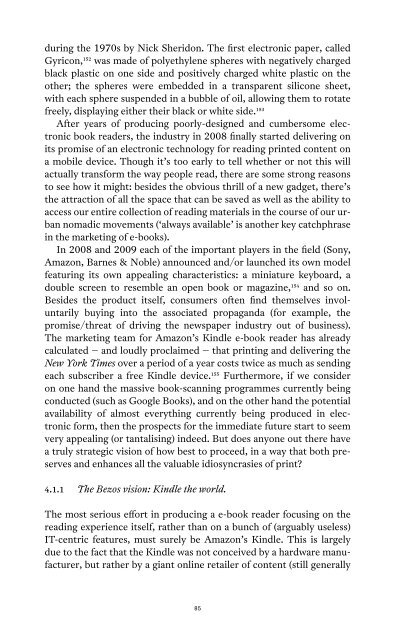Post- Digital Print - Monoskop
Post- Digital Print - Monoskop
Post- Digital Print - Monoskop
You also want an ePaper? Increase the reach of your titles
YUMPU automatically turns print PDFs into web optimized ePapers that Google loves.
during the 1970s by Nick Sheridon. The first electronic paper, called<br />
Gyricon, 152 was made of polyethylene spheres with negatively charged<br />
black plastic on one side and positively charged white plastic on the<br />
other; the spheres were embedded in a transparent silicone sheet,<br />
with each sphere suspended in a bubble of oil, allowing them to rotate<br />
freely, displaying either their black or white side. 153<br />
After years of producing poorly-designed and cumbersome electronic<br />
book readers, the industry in 2008 finally started delivering on<br />
its promise of an electronic technology for reading printed content on<br />
a mobile device. Though it’s too early to tell whether or not this will<br />
actually transform the way people read, there are some strong reasons<br />
to see how it might: besides the obvious thrill of a new gadget, there’s<br />
the attraction of all the space that can be saved as well as the ability to<br />
access our entire collection of reading materials in the course of our urban<br />
nomadic movements (‘always available’ is another key catchphrase<br />
in the marketing of e-books).<br />
In 2008 and 2009 each of the important players in the field (Sony,<br />
Amazon, Barnes & Noble) announced and/or launched its own model<br />
featuring its own appealing characteristics: a miniature keyboard, a<br />
double screen to resemble an open book or magazine, 154 and so on.<br />
Besides the product itself, consumers often find themselves involuntarily<br />
buying into the associated propaganda (for example, the<br />
promise/threat of driving the newspaper industry out of business).<br />
The marketing team for Amazon’s Kindle e-book reader has already<br />
calculated – and loudly proclaimed – that printing and delivering the<br />
New York Times over a period of a year costs twice as much as sending<br />
each subscriber a free Kindle device. 155 Furthermore, if we consider<br />
on one hand the massive book-scanning programmes currently being<br />
conducted (such as Google Books), and on the other hand the potential<br />
availability of almost everything currently being produced in electronic<br />
form, then the prospects for the immediate future start to seem<br />
very appealing (or tantalising) indeed. But does anyone out there have<br />
a truly strategic vision of how best to proceed, in a way that both preserves<br />
and enhances all the valuable idiosyncrasies of print?<br />
4.1.1 The Bezos vision: Kindle the world.<br />
The most serious effort in producing a e-book reader focusing on the<br />
reading experience itself, rather than on a bunch of (arguably useless)<br />
IT-centric features, must surely be Amazon’s Kindle. This is largely<br />
due to the fact that the Kindle was not conceived by a hardware manufacturer,<br />
but rather by a giant online retailer of content (still generally<br />
85

















